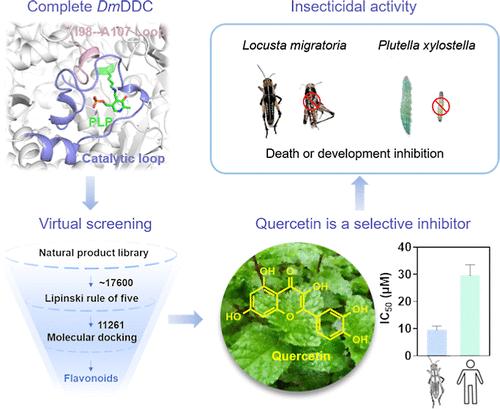昆虫多巴脱羧酶作为潜在杀虫剂靶点的验证及选择性先导化合物的发现
IF 6.2
1区 农林科学
Q1 AGRICULTURE, MULTIDISCIPLINARY
引用次数: 0
摘要
多巴脱羧酶(Dopa decarboxylase, DDC)是参与昆虫角质层鞣制的关键限速酶,催化左旋多巴转化为多巴胺。鉴于其在昆虫生存中的重要作用,DDC是害虫防治的潜在目标。在这项研究中,我们重组表达和表征了黑腹果蝇的DDC,并建立了一个用于虚拟筛选的结构模型。槲皮素(Quercetin, Que)是第一个被鉴定出的昆虫DDC抑制剂,IC50值为9.43 μM。值得注意的是,Que对人DDC的抑制活性较低,IC50值为29.56 μM。序列结构比较和分子对接揭示了催化环(L330、N326、V327和D335)中几个氨基酸的差异,这可能解释了昆虫和哺乳动物ddc之间不同的底物特异性,以及不同的抑制剂敏感性。对鳞翅目害虫小菜蛾和直翅目害虫迁徙蝗具有显著的杀虫活性。这项研究不仅加强了针对昆虫DDC的杀虫剂开发潜力,而且为进一步的杀虫剂设计确定了一个有前途的先导支架。本文章由计算机程序翻译,如有差异,请以英文原文为准。

Validation of Insect Dopa Decarboxylase as a Potential Insecticide Target and Discovery of Selective Lead Compounds
Dopa decarboxylase (DDC) is a key rate-limiting enzyme involved in cuticle tanning in insects, catalyzing the conversion of l-dopa to dopamine. Given its essential role in insect survival, DDC represents a potential target for pest control. In this study, we recombinantly expressed and characterized DDC from Drosophila melanogaster and developed a structural model for virtual screening. Quercetin (Que), the first identified inhibitor of insect DDC, was found to have an IC50 value of 9.43 μM. Notably, Que displayed much lower inhibitory activity against human DDC, with an IC50 value of 29.56 μM. Sequence-structure comparisons and molecular docking revealed several amino acid differences in the catalytic loop (L330, N326, V327, and D335) that may account for the distinct substrate specificity between insect and mammalian DDCs, as well as the differential inhibitor sensitivities. Bioassays demonstrated that Que exhibited significant insecticidal activity against the lepidopteran pest Plutella xylostella and the orthopteran pest Locusta migratoria. This study not only reinforces the potential of targeting insect DDC for insecticide development but also identifies a promising lead scaffold for further insecticide design.
求助全文
通过发布文献求助,成功后即可免费获取论文全文。
去求助
来源期刊
CiteScore
9.90
自引率
8.20%
发文量
1375
审稿时长
2.3 months
期刊介绍:
The Journal of Agricultural and Food Chemistry publishes high-quality, cutting edge original research representing complete studies and research advances dealing with the chemistry and biochemistry of agriculture and food. The Journal also encourages papers with chemistry and/or biochemistry as a major component combined with biological/sensory/nutritional/toxicological evaluation related to agriculture and/or food.

 求助内容:
求助内容: 应助结果提醒方式:
应助结果提醒方式:


